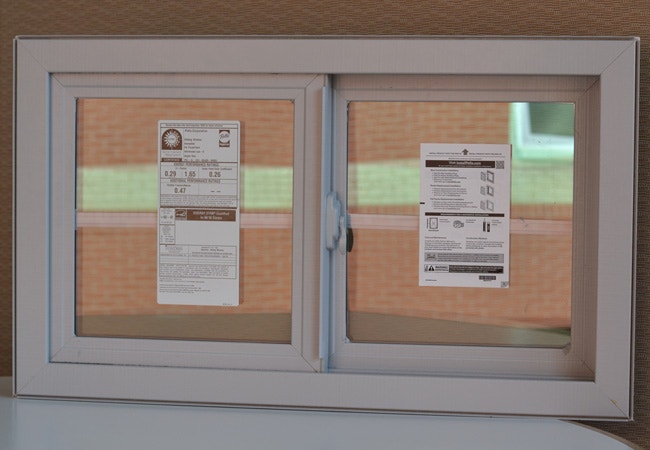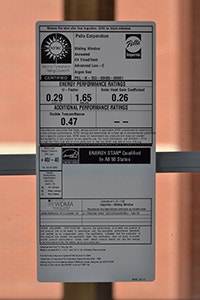How to Read Window Labels
With a better understanding of the different ratings on a window label, you can be confident you’re making the decision that is right for you.

KEY TAKEAWAYS
- Understanding NFRC window labels is key to comparing products and making energy-efficient choices.
- Primary NFRC ratings include U-Factor, Solar Heat Gain Coefficient, Visible Transmittance, and Air Leakage.
- Optimal window ratings depend on climate and region—consult local experts for tailored recommendations.
A window label can tell you a lot about the performance and energy efficiency of a product. Read about the primary factors that are measured on a window label and you’ll be adequately prepared to compare different brands and types of windows — ultimately helping you select a window that is right for your home.
4 Primary Measurements of an NFRC Label
If you’ve started to shop for windows, you might have noticed a sticker on each window with various numbers and abbreviations. This is the NFRC, or National Fenestration Rating Council®, label. This independent, nonprofit organization rates and certifies windows and doors according to strict requirements.
The NFRC doesn’t recommend which windows to buy. Instead, they help you do an apples-to-apples comparison of different brands and types of windows, helping you pick the right products for your lifestyle and budget.
At first glance, the NFRC label can be a bit confusing, but we’ll help you decode it. The NFRC’s ratings measure four primary qualities. It’s also important to remember that primary NFRC ratings assume proper window installation.
U-Factor
The U-Factor tells you how well a window insulates. This measurement tells us the rate at which the product conducts non-solar heat flow. U-Factor ratings tend to fall within a range between .20 and 1.20. The lower the U-Factor, the better insulation the window will provide, so when you’re shopping for energy-efficient windows, look for a product with a low U-Factor.
Solar Heat Gain Coefficient
The solar heat gain coefficient, or SHGC, rates how effective a window is at blocking the sun’s radiant heat. The SHGC measures how much solar radiation passes directly through your window and how much heat is absorbed by the window and passed indirectly into your home. SHGC is indicated on an NFRC label by a number between 0 and 1. The lower the solar heat gain coefficient, the less solar heat the window allows into your home.
A product with a higher SHGC number will allow more warming sunlight into your home during colder months, while a window with a low SHGC number will be better at blocking radiant heat during warmer months. The climate you live in, as well as the direction your home faces, will determine what SHGC rating is ideal for your windows.
Visible Transmittance
Visible transmittance, or VT, quantifies how much visible light a window allows into your home. The VT is expressed as a number between 0 and 1. There are a number of factors that can influence VT, including how many panes of glass a window has and any special coatings that may be on the glass, including a Low-E coating or a reflective coating on tinted glass. Windows use various degrees of tinting to control energy efficiency, solar heat gain and how much light can enter a space. A product with a higher VT rating will permit more natural light into a space, while you will notice more tinting on a product with a lower VT rating.
Air Leakage
Air leakage measures how much air a window will let into your home. Air leakage ratings tend to fall within a range between .1 and .03. A low number indicates a tighter product that lets less air pass through, meaning fewer drafts for you. It’s important to note that this rating is optional and not every manufacturer chooses to include it on their NFRC labels. It’s also important to remember that this rating, like all of the primary NFRC ratings, assumes proper window installation.
The NFRC label may also include the ENERGY STAR® logo. If it does, that means the window meets the ENERGY STAR® guidelines in the region of the country indicated on the map on the label. Pella proudly offers windows that meet or exceed ENERGY STAR® guidelines in all 50 states.1

Putting NFRC Labels to Use
Now that you know what your window labels are telling you, what should you aim for in terms of rating ranges for your windows? That depends in large part on where you live.
The glass choice for a window that’s efficient in Miami, for instance, would actually cost a person in Maine more money and it would make that home less comfortable — and vice versa. Your local window expert can help you determine which rating levels are appropriate for your area and your needs.
Evaluating windows based on NFRC ratings will help you shorten your list of manufacturers. Your next step, then, is to decide between wood, fiberglass or vinyl windows and then identify the type of window you prefer. Read more about the differences between window materials and how to choose the perfect product for your home.


